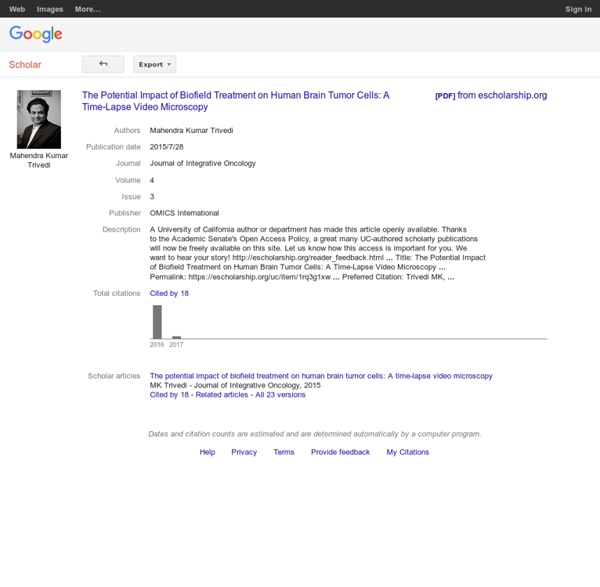



Hanks Balanced Salt Solution - An Evaluation of Biofield Treatment Comparative Physicochemical Evaluation of Biofield Treated Phosphate Buffer Saline and Hanks Balanced Salt Medium Phosphate buffer saline (PBS) has numerous biological and pharmaceutical applications. Hank buffer salt (HBS) has been used as a medium for tissue culture applications. This research study was aimed to investigate the influence of Mr. Trivedi's biofield energy treatment on physicochemical properties of the PBS and HBS. The Potential Impact of Biofield Treatment on Human Brain Tumor Cells: A Time-Lapse Video Microscopy Share this: Embed* Cite this: Publication meta - The Potential Impact of Biofield Treatment on Human Brain Tumor Cells: A Time-Lapse Video Microscopy - Publications Study background: Glioblastoma (GBM) is the most common subtype of primary brain tumor in adults. The aim was to evaluate the impact of biofield treatment potential on human GBM and non-GBM brain cells using two time-lapse video microscopy technique. Methods: The human brain tumor, GBM cultured cells were divided into two groups viz. GBM control and GBM treatment. Similarly, human normal brain cultured cells (non-GBM) were taken and divided into two groups viz. non- GBM control and non-GBM treatment.
Human Energy Treatment for Increasing Tomato Yield Abstract: Recent studies report the effect of biofield treatment on changes in structural characteristics of organic and inorganic matter, on cancer cells in vitro and on overall plant development. This study tested the impact of the same treatment applied to lettuce and tomato seeds and transplants (Lactuca sativa var. capitata and Lycopersiconesculentum var. Roma) in commercial plantings with and without fertilizers and pesticides, in relation to yield, quality, and pest inhibition. Treated lettuce plants with fertilizer and pesticide applications were more vigorous, exhibited less incidence of soil-borne fungal wilt, and subsequent yield was statistically greater 43% compared to untreated plants. The Potential Impact of Biofield Treatment on Human Brain Tumor Cells: A Time-Lapse Video Microscopy Abstract Study background: Glioblastoma (GBM) is the most common subtype of primary brain tumor in adults. The aim was to evaluate the impact of biofield treatment potential on human GBM and non-GBM brain cells using two time-lapse video microscopy technique.
"The Potential Impact of Biofield Treatment on Human Brain Tumor Cells:" by Mahendra Kumar Trivedi Description Study background: Glioblastoma (GBM) is the most common subtype of primary brain tumor in adults. The aim was to evaluate the impact of biofield treatment potential on human GBM and non-GBM brain cells using two time-lapse video microscopy technique. Methods: The human brain tumor, GBM cultured cells were divided into two groups viz. GBM control and GBM treatment. Investigation of antimicrobial susceptibility of E. cloacae Abstract Soybean production in Iowa USA is among the most productive for raínfed regions in the world. Despite generally having excellent soils, growing season temperatures and rainfall, soybean yields are decreased by weed interference and inadequate available soil water at key stages of crop development. A field study was conducted at two locations in lowa in 2012 to determine if seed-applied fungicide or biofield treatments influenced weed community, soil volumetric water concentration and soybean yield and quality. Application of biofield treatment resulted in lower density of tall waterhemp density, greater soybean stand density at R8 stage and greater seed pod-1 compared to the absence of seed fungicide and biofield Soil volumetric water content varied by seed fungicide x biofield x date interaction but differences were not consistent among treatment combinations. Download the original manuscript
The Potential Impact of Biofield Treatment on Human Brain Tumor Cells Open Access o u r The Potential Impact of Biofield Treatment on Human Brain Tumor Cells: A Time-Lapse Video Microscopy Title: The Potential Impact of Biofield Treatment on Human Brain Tumor Cells: A Time-Lapse Video Microscopy Select license: Creative Commons Attributions-NonCommercial-ShareAlike Updated: November 19th, 2016 Evaluation of Phenotype and Genotype of Enterobacter Aerogenes Abstract Enterobacter aerogenes (E. aerogenes) has been commonly described as a versatile opportunistic pathogen in hospital infections. The aim of the present work was to evaluate the impact of biofield treatment on E. aerogenes for its phenotypic and genotypic characteristics. E. aerogenes bearing ATCC 13048 (American Type Culture Collection) was procured from Bangalore Genei, in sealed pack and divided into control and treated groups.
Antimicrobial Susceptibility, Biochemical Characterization and Molecular Typing of Biofield Treated Klebsiella pneumoniae - Trivedi Science Abstract: Pathogenic isolates of Klebsiella pneumoniae (K. pneumoniae), particularly the extended-spectrum β-lactamase (ESBL) producing strains, are mostly associated with the failure of antibiotic therapy in nosocomial infections. The present work was designed to evaluate the impact of Mr. Impact of Biofield Treatment on Enterobacter Aerogenes Abstract: Enterobacter aerogenes (E. aerogenes) has been reported as the versatile opportunistic pathogen associated with the hospital infections worldwide. The aim of the study was to determine the impact of Mr. Trivedi’s biofield energy treatment on multidrug resistant clinical lab isolates (LSs) of E. aerogenes. The MDR isolates of E. aerogenes (i.e., LS 45 and LS 54) were divided into two groups, i.e., control and treated.
Study of Antimicrobial susceptibility of S. Marcescens Abstract Serratia marcescens (S. marcescens) is Gram-negative bacterium, associated with hospital-acquired infections (HAIs), especially urinary tract and wound infections. The present study was aimed to evaluate the impact of biofield treatment on phenotyping and genotyping characteristics such as antimicrobial susceptibility, biochemical reactions, biotype, DNA polymorphism, and phylogenetic relationship of S. marcescens (ATCC 13880). The lyophilized cells of S. marcescens were divided into three groups (G1, G2, and G3).